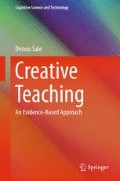Abstract
The title of the book ‘Fifteen Thousand Hours’ by Rutter et al. (1982) is based on the approximate number of hours a pupil spends in school. So, what did I learn in my 15,000 h? Well, I certainly acquired two really useful skill-sets, football and boxing. I still play football, albeit not in my favoured utility midfield role; rather now as a languid right back, protected by a much younger and faster midfielder in front of me. What makes football such a good learning experience and useful skill-set to learn? Travel practically anywhere in the world and you will easily find footballers, who play in teams either in organized leagues or social set ups. They love the game and the ‘crack’ (I think this term has Irish origins, ‘craic’—loosely means fun; apologies if I’m wrong).
Teaching is the only major occupation of man for which we have not yet developed tools that make an average person capable of competence and performance. In teaching we rely on the ‘naturals’, the ones who somehow know how to teach.
Peter Drucker (1999)
Access this chapter
Tax calculation will be finalised at checkout
Purchases are for personal use only
References
Anderson, J. R., et al. (1998). Radical constructivism and cognitive psychology. In D. Ravitch (Ed.), Brookings papers on education policy: 1998 (pp. 227–255). Washington, D.C.: Brookings Institution.
Berger, P. L., & Luckmann, T. (1967). The social construction of reality: A treatise in the sociology of knowledge. New York: Anchor Books.
Bransford, J., et al. (1999). How people learn: Brain, mind, experience and school. Washington, D.C: National Academy Press.
Darling-Hammond, L., & Bransford, J. (2005). Preparing teachers for a changing world: What teachers should learn and be able to do. San-Francisco: Jossey-Bass.
Drucker, P. (1999). Quote. Available at: http://www.brainyquote.com/quotes/authors/p/peter_drucker.html. Last accessed, December 8th, 2014.
Eisner, E. W. (1995). The art and craft of teaching. In A. C. Ornstein & L. S. Behar Contemporary issues in curriculum. MA: Allyn & Bacon.
Galbraith, J. K. (1958). The affluent society. New York: Houghton Mifflin Harcourt.
Hattie, J. (1999, August 2). Influences on student learning. Inaugural Lecture. University of Auckland.
Hattie, J. (2009). Visible learning. New York: Routledge.
Hattie, J. (2012). Visible learning for teachers: Maximizing impact on learning. London: Routledge.
Hattie, J., & Yates, G. C. R. (2014). Visible learning and the science of how we learn. New York: Routledge.
Izumi, T. L., & Evers, W. M. (2002). Teacher quality. San Francisco: Hoover Institutional Press.
Kuhn, T. S. (1996). The structure of scientific revolutions. Chicago: The University of Chicago Press.
Lincoln, Y. S. (1990). The making of a constructivist: A remembrance of transformations past. In E. G. Guba (Ed.), The paradigm dialogue. London: Sage.
Mansell, W. (2008, November 21). Research reveals teaching’s Holy Grail. TES Newspaper.
Martin, R. (2009). The design of business. MA: Harvard Business Press.
Marzano, R. J. (1992). A Different Kind of Classroom. Alexandria: VA: ASCD.
Marzano, R. J. (2007). The art and science of teaching: A comprehensive framework for effective instruction. Alexandria: ASCD.
Mayer, R. (2004). Should there be a three-strikes rule against pure discovery learning? The case for guided methods of instruction. American Psychologist, 59(1), 14–19).
Mayer, R. E., & Alexander, P. A. (2010). Handbook of research on learning and instruction. London: Routledge.
Ornstein, A. C. (1995). Teaching: Theory into practice. Needham Heights, MA: Allyn & Bacon.
Perkins, D. N. (1992). Smart schools. London: The Free Press.
Petty, G. (2009). Evidence-based teaching: A practical approach. Cheltenham: Nelson Thornes.
Phillips, D. C. (1990). Postpositivistic science: Myths and realities. In E. G. Guba (Ed.), The paradigm dialogue. London: Sage.
Pratt, D. D. (2002). Good teaching: One size fits all? In J. M. Ross-Gordon (Ed.), Contemporary viewpoints on teaching adults effectively (Vol. 93, pp. 5–15). Spring 2002. San Francisco: Jossey-Bass.
Ramsden, P. (1992). Learning to teach in higher education. London: Routledge.
Rowe, K. J., & Rowe, K. S. (1993). Assessing student behavior: The utility and measurement properties of a simple parent and teacher-administered behavioural rating instrument for use in educational and epidemiological research. Paper presented at the annual conference of the Australian Association for Research in Education, Fremantle, WA.
Rutter, M., et al. (1982). Fifteen thousand hours: Secondary schools and their effects on children. Cambridge, MA: Harvard University Press.
Sallis, E., & Hingley, P. (1991). College quality assurance systems in Mendip Paper D20. Bristol: Coombe Lodge.
Schank, R. (2011). Teaching minds: How cognitive science can save our schools. New York: Teacher College Press.
Stone, J. E. (2000, May 12) Teacher training and pedagogical methods. Institution/Pacific Research Institute Teacher Quality Conference, Hoover.
Thomas, L. (1979). The medusa and the snail: More notes of a biology watcher. New York: Viking Press.
Author information
Authors and Affiliations
Corresponding author
Rights and permissions
Copyright information
© 2015 Springer Science+Business Media Singapore
About this chapter
Cite this chapter
Sale, D. (2015). Making Sense of Teaching. In: Creative Teaching. Cognitive Science and Technology. Springer, Singapore. https://doi.org/10.1007/978-981-287-534-1_1
Download citation
DOI: https://doi.org/10.1007/978-981-287-534-1_1
Published:
Publisher Name: Springer, Singapore
Print ISBN: 978-981-287-533-4
Online ISBN: 978-981-287-534-1
eBook Packages: EngineeringEngineering (R0)

